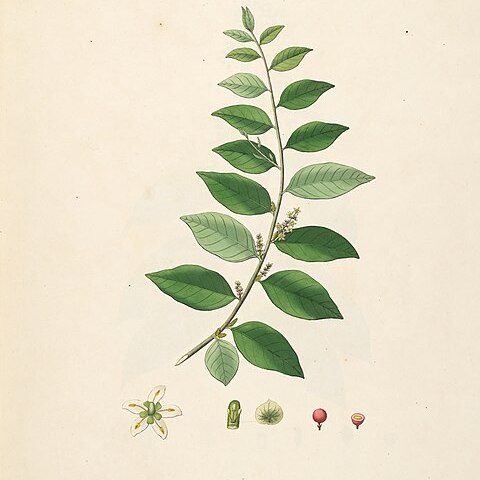A shrub or woody climber. It grows off other trees and plants. It grows to 4-10 m tall and has stems 20 cm across. The bark is rough and light grey. It has furrows along it and is corky. The aerial branches often hang downwards. The leaves are fairly smooth and leathery. They are 5-14 cm long by 2-5 cm wide. The midrib is prominent underneath the leaf. The leaf has a pointed tip. The leaf stalk is 0.3-0.7 cm long. The new leaves are bright shiny green. The base of the leaves is slightly curved backwards. The flowers are very small and yellow green. They are star shaped. They have a sweet scent. Many flowers occur together on short stalks around a central stem. These occur in the axils of leaves and are 2-3.5 cm long. The fruit can occur singly or in clusters. The fruit are oval and fleshy. The flesh is white. They are 1.5-3 cm long by 1.2-1.8 cm wide. They are pale yellow or orange when ripe. The fruit are edible. They have one seed inside. The seed is 21 mm long by 15 mm wide.
Liana up to 30 m or erect shrub; bark smooth or fissured, pale to dark grey, branches glabrous or glabrescent. Leaves mostly glabrous; ovate, oblong, or lanceolate, 5-14 (-16) by 2-5 cm; apex acuminate, acute, or obtuse; base attenuate, sometimes rounded; midrib prominent beneath; nerves (6-) 7-9 (-11) pairs; petiole 3-7 (-10) mm. Racemes 1-5 in the axil of one leaf, 1.5-3.5 cm long when flowering; bracts 2-3 mm Ө, with ciliate margin. Pedicels of 1.5-2 mm. Tepals yellowish green, oblong with a short inflexed top, shortly pubescent outside, c. 1.5 mm long. Filaments filiform, 1.5 mm; anthers oval, 0.3 mm long. Disk lobes subclavate, green, c. 0.5 mm long. Ovary c. 1 mm long. Drupe orange-yellow, 1.5-3 by 1.25-1.75 cm; pedicels thickened upwards, 5-7 mm.
Lianas, to 30 m. Branches glabrescent. Petiole 5-10 mm; leaf blade lanceolate, ovate, or oblong, 7-14 × 3-5 cm, ± leathery, glabrous, base cuneate to sometimes rounded, apex acute to acuminate, midvein abaxially prominent; veins 7-9 on each side of midvein. Racemes 1 or 2, axillary, 2-4 cm, brownish tomentose; bracts broadly ovate, 2-3 mm. Pedicel 1.5-2 mm, puberulous. Tepals yellowish green, oblong, ca. 1.5 mm, pubescent. Filaments filiform, ca. 1.5 mm; anther ca. 0.3 mm. Disk lobes ± clavate, ca. 0.5 mm. Ovary ca. 1 mm. Drupe reddish, ellipsoid, 2.5-3 × 1.4-1.6 cm; stipe thickened, ca. 5 mm. Fl. and fr. Apr-Jun. 2n = 20.

